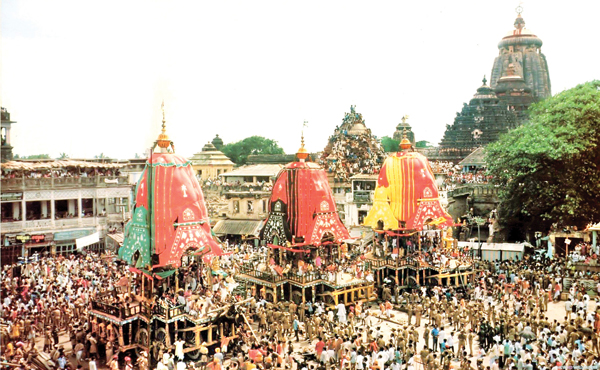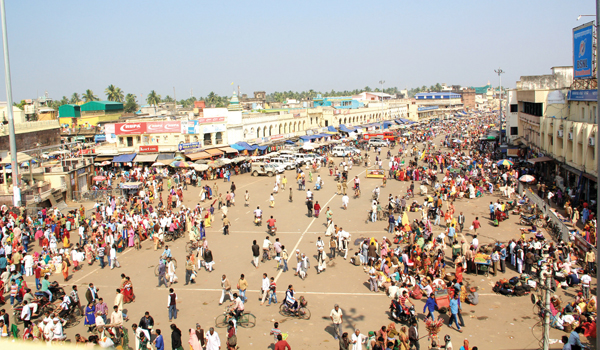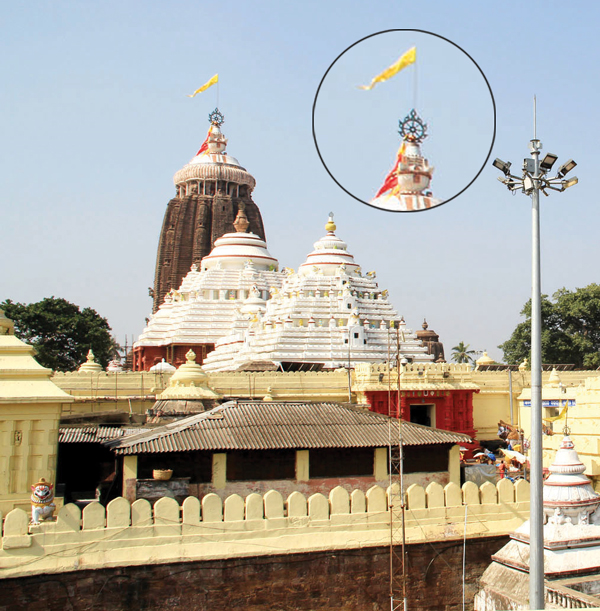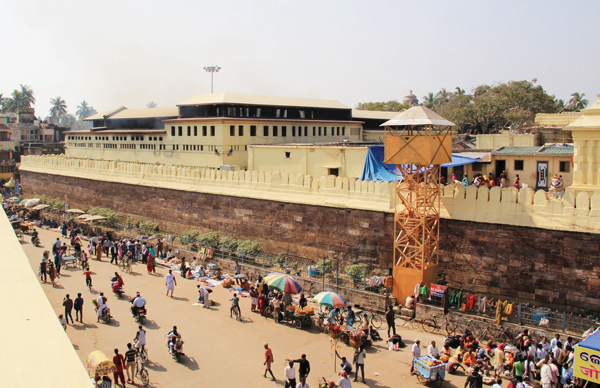Contents [hide]
- 1. Shri Balaram’s rath heads the Rathyatra, in middle is Subhadra-devi’s rath, followed by Bhagwan Jagannath’s rath !
- 2. Unique names of all three raths and their specific features !
- 3. Bhagwan Jagannath resides at His Aunt’s (Mausi) place for 7 days
- 4. Amazing and unbelievable features of Shri Jagannath temple !
World famous Jagannath Yatra is a great event for devotees of Bhagwan Jagannath, that is Shrikrushna. Puri is one of the places among the 4 famous pilgrim places (Char Dham). Not only from Bharat but devotees from all over the world rush to attend this yatra which exhibits tremendous faith and devotion. This is the greatest yatra where millions of devotees of Shri Vishnu come together. In most temples Shrikrushna is accompanied by His wife; but this temple is unique because in this temple He appears with His brother Balaram and sister Subhadra.
Puri is a land of Shri Vishnu. Along with many specific features which are beyond intellect, the one which is very unique is that as soon as we enter the main gate of the temple, the sound of the ocean which is normally heard throughout Puri city, stops completely. Let us experience the unusual history, ancient features and present condition of the Rathyatra in the temple in the article given ahead !
1. Shri Balaram’s rath heads the Rathyatra, in middle is Subhadra-devi’s rath, followed by Bhagwan Jagannath’s rath !

Jagannath temple in Puri is one amongst the 4 main pilgrim places (4 Dhams). The temple having Shri Jagannath is more than 800 years old. Along with Shrikrushna, His elder brother Shri Balaram and His sister Subhadra-devi are worshipped here. Three different chariots (Raths) are made for Shri Balaram, Shrikrushna and Devi Subhadra. The rath of Shri Balaram is heading the procession, middle is Devi Subhadra’s rath which is followed by Shri Jagannath’s (Shrikrushna’s) rath.

2. Unique names of all three raths and their specific features !
2 a. Shri Balaram’s rath is known as ‘Taladhwaj’. It is red and green in colour. Devi Subhadra’s rath is called ‘Darpadalan’ or ‘Padmarath’. It is either black or blue or red in colour. Bhagwan Jagannath’s rath is known as ‘Nandighosh’ or ‘Garudadhwaj’. It is red and yellow in colour.
2 b. The height of Shri Balaram’s rath is 45 ft., Subhadra-devi’s rath 44.6 ft. and Bhagwan Jagannath’s Nandighosh rath is 45.6 ft.
2 c. All these three raths are made of holy and seasoned wood of neem tree. A very healthy and auspicious tree is selected for this purpose. A specific committee is established for this. No metal is used in their making – this is another unique feature of the raths.
2 d. Wood is selected on an auspicious time, which happens to be Vasant Panchami. From this day logs of wood are selected. The real preparation of raths starts from Akshayya Trutiya.
2 e. A ritual called ‘Chhar Pahanara’ is performed at the completion of these three raths. In this ritual, the Gajapati King of Puri comes in a Palanquin and performs the ritualistic worship. At this time, it is a tradition to clean the interior of the raths and the road with broom of gold.
2 f. Thereafter the raths start moving. Rathyatra commences on Ashadh Shukla Paksha Dwitiya. Devotees pull the raths amidst playing Drums and nagaras (big drums), blowing trumpet and conch shell. Devotees have faith that those who get the chance to pull the raths are virtuous, which is as per the Puranas that those who pull the raths attain Final liberation (Moksha).
3. Bhagwan Jagannath resides at His Aunt’s (Mausi) place for 7 days
3 a. Commencing the Rathyaytra from Jagannath temple, it moves in the whole city of Puri and reaches at Gundicha temple. Here Bhagwan Jagannath, Shri Balaram and Subhadra-devi stay for 7 days.
3 b. Gundicha temple is also known as Gundicha Badi. This is Bhagwan Jagannath’s aunt’s house. Vishwakarma had created the idols of Bhagwan Jagannath, Shri Balaram and Subhadra-devi here.
3 c. On the third day of Rathyatra, that is on Pancham, Devi Lakshmi comes here in search of Bhagwan Jagannath. At that time, Detapati shuts the door. Getting furious about it, the Goddess breaks a leg of the rath and returns to Devi Lakshmi’s temple in the area known as Hera Gohiri Sahi (A place in Puri).
3 d. hereafter as the tradition goes, Bhagwan Jagannath tries to persuade Devi Lakshmi. Through the medium of this festival an unusual essence of devotion (Bhaktirasa) is created.
3 e. On the 10th day of Ashadh month, these chariots return to the main temple. This returning yatra is called ‘Bahuda yatra’.
3 f. After returning to Shri Jagannath temple also, all idols remain in the chariots only. The temple doors are opened for them on the next day, that is on Ekadashi. That time these idols are bathed ritually and are reinstalled amidst chanting of mantras.
3 g. Puri’s Rath festival is a collective festival. The residents of Puri do not fast during this period. It is considered to be a great fortune to be a witness of this world famous Rathyatra in Puri, based at the shore of the ocean. Devotees conserve the bhav (devotion) in their mind waiting eagerly for the next year’s Rathyatra. Nowhere else will you be able to see such faith and devotion which you see on the occasion of Rathyatra. Therefore this ceremony is rare and unique. (Ref. : The internet)
4. Amazing and unbelievable features of Shri Jagannath temple !

The architecture of the 800 years old ancient temple is so magnificent that architects from all over the world pay a visit to this temple to do research on it. This is one of the 4 sacred Dhams in Bharat. The height of the temple is 214 ft. The temple area comprises 4 lac sq. ft. If we try to see the Sudarshan Chakra on the apex of the temple from any place in Puri, it appears like, it is in front of us. The flag on the temple flutters in the opposite direction of the wind. (We can realise the unique importance of Hindu Dharma from this ! – Editor )
The flag on the temple is changed every evening. Normally wind blows from the sea to earth and in the evening it blows in the opposite direction; but in Puri, it is just the opposite.
The shadow of the main dome is invisible any time of the day.
We can never see birds and aeroplanes flying over the temple.
Food enough for a whole year is stored here. The Mahaprasad is never wasted. The kitchen in the temple is the biggest of all that in any other temple. Earthen pots are placed one on top of the other while preparing Mahaprasad. Fire wood is is used as fuel for cooking food. In this huge kitchen, Mahaprasad is prepared according to Shri Jagannath’s liking. 500 cooks and 300 assistants cook the Mahaprasad together.


 The self-manifested temple of Shri Dhareshwar at Dhayari, Pune
The self-manifested temple of Shri Dhareshwar at Dhayari, Pune Qutub Minar, in reality an amazing astronomical observatory Merustambh built by Acharya Varahmihir !
Qutub Minar, in reality an amazing astronomical observatory Merustambh built by Acharya Varahmihir ! The Sun temple in Bihar which changed its direction overnight !
The Sun temple in Bihar which changed its direction overnight ! Alandi
Alandi The Amarnath Yatra that bestows humans with the merit of visiting 23 holy places of...
The Amarnath Yatra that bestows humans with the merit of visiting 23 holy places of...